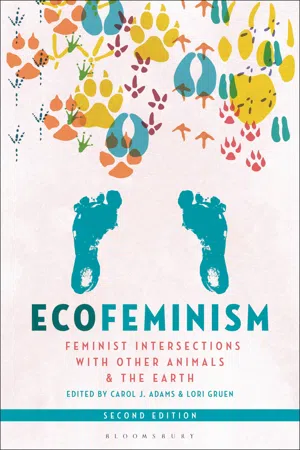
Ecofeminism, Second Edition
Feminist Intersections with Other Animals and the Earth
- 472 pages
- English
- ePUB (mobile friendly)
- Available on iOS & Android
Ecofeminism, Second Edition
Feminist Intersections with Other Animals and the Earth
About this book
This new edition of Ecofeminism: Feminist Intersections with Other Animals and the Earth begins with an historical, grounding overview that situates ecofeminist theory and activism within the larger field of ecocriticism and provides a timeline for important publications and events. Throughout the book, authors engage with intersections of gender, sexuality, gender expression, race, disability, and species to address the various ways that sexism, heteronormativity, racism, colonialism, and ableism are informed by and support animal oppression. This collection is broken down into three separate sections: - Affect includes contributions from leading theorists and activists on how our emotions and embodiment can and must inform our relationships with the more-than-human world
- Context explores the complexities of appreciating difference and the possibilities of living less violently
- Climate, new to the second edition, provides an overview of our climate crisis as well as the climate for critical discussion and debate about ecofeminist ideas and actions Drawing on animal studies, environmental studies, feminist/gender studies, and practical ethics, the ecofeminist contributors to this volume stress the need to move beyond binaries and attend to context over universal judgments; spotlight the importance of care as well as justice, emotion as well as reason; and work to undo the logic of domination and its material implications.
Frequently asked questions
- Essential is ideal for learners and professionals who enjoy exploring a wide range of subjects. Access the Essential Library with 800,000+ trusted titles and best-sellers across business, personal growth, and the humanities. Includes unlimited reading time and Standard Read Aloud voice.
- Complete: Perfect for advanced learners and researchers needing full, unrestricted access. Unlock 1.4M+ books across hundreds of subjects, including academic and specialized titles. The Complete Plan also includes advanced features like Premium Read Aloud and Research Assistant.
Please note we cannot support devices running on iOS 13 and Android 7 or earlier. Learn more about using the app.
Information
1
Ecofeminist Footings
Ecofeminist philosophy: A brief overview

Sentiment in patriarchal spaces
Table of contents
- Cover
- Half-Title Page
- Dedication
- Title Page
- Contents
- List of illustrations
- Notes on contributors
- Acknowledgments (first edition)
- Acknowledgments (second edition)
- Preface
- Timeline
- 1 Ecofeminist Footings
- Part one Affect
- 2 Caring to Dialogue: Feminism and the Treatment of Animals
- 3 Compassion and Being Human
- 4 Ecology is a Sistah’s Issue Too
- 5 Joy
- 6 Eros and the Mechanisms of Eco-Defense
- 7 Interdependent Animals: A Feminist Disability Ethics of Care
- 8 Facing Death and Practicing Grief
- Part two Context
- 9 Inter-animal Moral Conflict and Moral Repair: A Contextualized Ecofeminist Approach in Action
- 10 Michael Vick, Race, and Animality
- 11 Caring Cannibals and Human(e) Farming: Testing Contextual Edibility for Speciesism
- 12 Ecofeminism and Veganism: Revisiting the Question of Universalism
- 13 Why a Pig?A Reclining Nude Reveals the Intersections of Race, Sex, Slavery, and Species
- 14 Toward New EcoMasculinities, EcoGenders, and EcoSexualities
- Part three Climate
- 15 Pussy Panic versus Liking Animals: Tracking Gender in Animal Studies
- 16 Black Feminist Ecological Thought: A Manifesto
- 17 The Animals Call it: Listening to the Climate Crisis
- 18 Global Atmospheres of Violence: Shifting Terrains of Othering in Ecofeminist Multispecies Witnessing
- 19 Maximum Plunder: The Global Context and Multiple Threats of Animal Agriculture
- 20 Upsetting Boundaries: Trans Queer Interspecies Ecofeminisms
- References
- Index
- Copyright